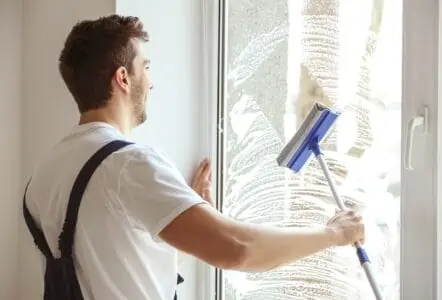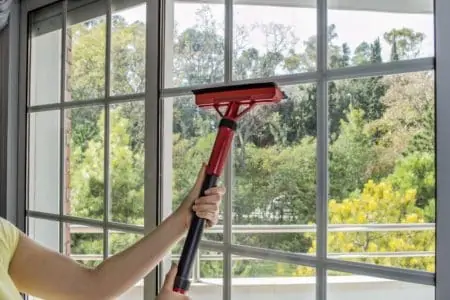Window cleaning is a big business with lots of interesting facts. But they’re not common knowledge. If you want to learn more window cleaning facts and statistics, you’re not alone.
That’s why we put together a list of 20 interesting tidbits of information. So whether you’re interested in the industry, want to know some more safety tips, or just need some more general knowledge under your belt — you’ve come to the right place.
Keep reading for 20 unusual and impressive window cleaning stats.
Top 20 Window Cleaning Facts and Statistics
- Window cleaning became more necessary during the construction boom of 1860.
- The squeegee was invented in the early 1900s.
- Windex was invented in 1936.
- The Victorians cleaned their windows by hand using vinegar, water, and cloths.
- The water-fed pole system changed window cleaning techniques in the 1990s.
- The US window cleaning market size is two billion dollars.
- The market is growing fast, with a seven percent increase prediction between 2016 and 2026.
- It’s one of the cheaper businesses to start yourself.
- More and more people need their windows cleaned due to more remote work and elderly people.
- Self-cleaning glass could risk window cleaners’ incomes.
- Before scaffolding was invented, this was a hazardous job.
- You must only wash windows in safe, dry weather without extreme heat, extreme cold, or high winds.
- You must take careful fall protection precautions.
- Ladders are one of the most dangerous aspects of being a window cleaner.
- Long pole systems are preferred so cleaners can keep both feet on the ground.
- A window cleaner in Dallas was left dangling 12 stories high after his scaffolding fell, but he survived.
- The average pay for a skyscraper window cleaner is 23 dollars per hour. On a 40-hour week, that’s a salary income of nearly 50,000 dollars.
- It can take months to clean a skyscraper.
- Skyscraper window cleaners see a bizarre range of things through the windows they clean.
- Robots could take over cleaning windows.
History of Window Cleaning
Are you wondering about the backstory of window cleaning? We have five interesting historical facts regarding window cleaning.
- Construction boom: Thanks to the construction boom in 1860, the demand for window cleaners began. With more buildings and, therefore, more glass, more window cleaners were required.
- Then came the squeegee: The best way to clean windows is with a squeegee. The original squeegee, which originated in the early 1900s, was big and heavy.
In fact, a fisherman’s tool used to scrape the fish residue off boat decks was used as inspiration. In 1936, the modern-day squeegee, which we know and recognize today, hit the market. - Windex hits the market: Windex, one of the most popular window cleaning products, appeared in 1936. During the Great Depression, Philip Drackett invented the famous glass cleaner.
- The Victorian way: Before the invention of the squeegee and Windex, Victorian servants or housewives would clean their windows with hot water, a bucket, and cleaning cloths. If necessary, they would add vinegar to shine the windows up and tackle grease. They even used newspapers to give it a final polish. What’s really cool is that we still use this technique today!
- The 1990s changed everything: The squeegee held its ground for many decades, but the water-fed pole system changed how professionals clean windows. This makes it much easier and quicker for window cleaners to get the job done without the need for ladders or cherry pickers.
Cleaning Services Industry Statistics
Are you interested in learning more data about the cleaning industry? Check out these impressive facts.
- Market size: The market size for the window washing industry in the US sits at two billion dollars, with over 39,000 businesses and 123,000 employees.
- It’s a fast-growing industry: The industry growth between 2016 and 2026 is predicted to increase by seven percent, which is more than many other industries. The good thing about window washing is that its recurring work with quick profits.
- It doesn’t take long to break even: If you’re considering stepping into the window-washing world, the good news is that it doesn’t take long to break even. You don’t need tons of equipment, nor is it that expensive. So once you start out in your new business venture, you could be earning profits shortly.
- The demographic is growing: With more people working at home, the residential requirement for clean windows has grown in the last few years. Plus, as people live to an older age, more people need help with such tasks. In return, this makes for many customers for window cleaners.
- Self-cleaning glass: One aspect of the industry that people are worried about is the rise of self-cleaning glass, which would eliminate the need for window cleaners. While this isn’t super popular yet, it’s something to watch out for.
Window Cleaning Safety
Window cleaning isn’t one of the safest jobs in the world. There come many risks with window cleaning. Here are some key facts.
- Before scaffolds: Thankfully, we now have scaffolding, which makes this job safer. But before scaffolding and secure platforms, window cleaners used window ledges to lean on taller buildings. In fact, one man from the 1900s would suspend a wooden chair using rope and hook a cotton belt around his waist to scale a building. Deaths were not uncommon back then.
- Weather makes for danger: A window cleaner must always check the weather before starting their working day (1). They shouldn’t work in extreme heat or expose themselves to too much sun. Windy days aren’t safe either. Some companies prohibit workers from cleaning in winds higher than 25 miles per hour. And to top it off, they shouldn’t work in the extreme cold either. There are a lot of factors that can make this job more dangerous.
- Falling hazard: The main risk for window cleaners is falling. To prevent this, window cleaners must work on surfaces with edge protection, such as a structural parapet or a guardrail at least 42 inches tall. They should also use a full body harness, rope grab, a lanyard, and an anchor point as fall protection. Cleaners must never walk on overhead glass in a skylight or atrium, making these windows more challenging to clean.
- Ladders are dangerous: While you might think hanging from a rope to clean windows is more dangerous, that’s not true these days. The fall protection in place is very effective. In the US, there has been only one high-rise death per year for the last four years. In fact, most falls from a window cleaner occur using portable ladders.
- Long pole systems are preferred: If a window cleaner can keep both feet on the ground and use a long-pole system to clean the windows, this is much safer. Window cleaners mustn’t take unnecessary risks or misuse equipment, which can increase the chances of injury.
Skyscraper Window Cleaner Facts
Have you ever wondered what it’s like to clean skyscrapers? These skyscraper window cleaner facts and statistics might just freak you out.
- Dallas skyscraper scaffolding fail: A skyscraper worker in Dallas was left dangling 12 stories high after his scaffolding fell. He was lowered to safety by a fire-rescue team. That’s why it’s vital to have fall prevention. Accidents can occur. That would have been quite a stressful working day for this window cleaner.
- Average pay: Skyscraper window cleaners make between 19 and 27 dollars per hour in the US (2). The median pay is 23 dollars per hour.
- It can take months to clean a skyscraper: Cleaning a skyscraper is no small task. For instance, six people take about four months to clean the Empire State Building. When they finish, they have to start all over again!
- Skyscraper window cleaners see it all: You won’t necessarily know when the window cleaner is coming round if you live in a high-rise building. Window cleaners see it all. They have seen people sleeping, using the bathroom, and walking around in their birthday suits!
- Robots could take over: While skyscraper window cleaning isn’t nearly as dangerous as it used to be, robots could still take over. This could minimize costs, overtime, and injuries.
FAQs
World of Window Washing
Before now, you probably took the job of window washers for granted. They come, set up, wet and wipe, then leave again.
But now that you know all the ins and outs of the industry, you might look at it a little differently. These 20 window cleaner facts and statistics might have opened your eyes to new and exciting information.
Or maybe, it’s tempted you right into the window-washing world. After all, it’s not the most difficult business to start. Plus, it’s actually a pretty safe job nowadays.







